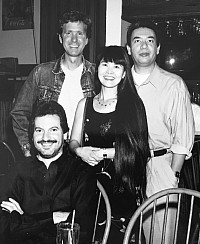Timeline I
"A Snapshot Perspective”
Exhibits & Work: 1986 - 2004
At CSU Fullerton, Hopkins became interested in the figurative nature of language, and began combining text with archetypal images that played with the structural nature of meaning.
At the same time, he began playing with the traditional "window" approach to painting by experimenting with alternative "window shapes". By the time of his MA show, he developed interacting shapes that played with right-brain and left-brain concepts. This interest in shapes eventually led to a more sculptural approach at Claremont Graduate University, along with a new "reductionism".
Hopkins's first solo exhibition after moving to downtown LA, was at Whittier College in 1994. Entitled "Vestiges and Constructions", it featured work from both his Rust-Stained Series, and Door-Skin Sculptures.
Hopkins's use of interior openings in both series literally encouraged the physical interaction of viewers by inviting them to peer or step inside. Some of his Door-Skin Sculptures even rocked-back-and-forth, thereby inviting viewers to playfully push or stand on them -- see announcement.
Michael Lewis Miller later curated some of Hopkins's work into a pair of group exhibits entitled "act, activate, analyze, ask..." at Barnsdale Junior Art Center, and "Action Required" at Huntington Beach Art Center.
Hopkins's solo venue for "Heterosis" was awarded him by Hello Artichoke Gallery after winning first prize in it's "Unusual Perceptions" competition, juried by Eleana Del Rio.
Hopkins's catalogue documents the transition of his work from his Rust-Stained Series to his Heterosis Series. It includes an essay by M.A. Greenstein.
In 1997, Hopkins also participated in the "The 6th International Shoebox Exhibition", a two-year traveling show. Hopkins's catalogue entry is a latter example of his Rust-Stained Series.
The pendulum swing of “reductionism” Hopkins began at CGU, culminated after moving to downtown LA with his Process Work Series -- an experimental body of "process art".
Eventually, his Rust-Stained Series marked a pendulum swing away from "reductionism". This was further highlighted by Hopkins's solo show "Calibrations" at Linfield College, Oregon, and his two-person show at Eastern Oregon University.
"Calibrations" was the first exhibit Hopkins received honorary airfare for attending and talking at the opening reception.
Hopkins's 1998 solo exhibit "Hybrid Vigor" introduced a "scatter approach" to his wall sculptures. (See announcement above.) It also premiered several works from his Rotating Paintings series, including a twisting "loop" of wood in one of his wall sculptures -- a precursor for his later Circadian Loops series.
Hopkins also began to experiment with loop-based "sound pieces" on his computer over the next several years -- becoming intrigued by the conceptual and formal notions of "loops", as well as by their bio-feedback effects on human physiology.
Visceralogy is a 3 CD compilation of Hopkins's sound pieces. Hopkins designed the CD artwork by photographing the rust-stained plastic he used during the process of making his Rust-Stained Series.

With friends: Richard Schroeder, Kristine Hatanaka, and Alan Valencia, 2000. (Photo by Toni Hernandez)
The downtown LA art scene brought together artists from different Southern California art school programs. The majority of Hopkins' friends derived from three artist circles -- CSU Fullerton, CSU Long Beach, and CGU.
In the Spring of 1998, Hopkins first began teaching for Santa Monica Community College in their Dual Enrollment Program, at the invitation of Kristine Hatanaka (CSUF), an art teacher at Culver City High School. It was both a welcomed source of teaching income, as well as an "educational" challenge on Hopkins' studio time.
Alan Valencia (CSPU Pomona), later Hatanaka's husband, invited Hopkins to apply for the "6th International Shoe Box Exhibition" in 1997.
Richard Schroeder (CSULB), was a graduating classmate from CGU. Together, Hopkins and Schroeder staked their ground in the downtime LA art scene at their studio loft, alongside the East 4th Street bridge, in 1990.
While teaching for Santa Monica Community College, Hopkins became increasingly interested in writing haiku as an ancillary project to his artwork -- a "portable art" that he could work on while away from the studio. He also became interested in "experimental text" in general. To this end he played with a treatise booklet format resulting in a few examples he printed out on his personal computer.
"Accretus Dictionarium", for example, is based on the random selection of dictionary words into sequential groupings of 1 to 14 words. This led Hopkins to create a form of writing he termed "scattered text" which also paralleled the "scattered cluster" of his wall sculptures.
Hopkins regarded the spacing of words in his "scattered text" as paralleling that of sculptural space. Their sense of movement is a pervasive quality throughout Hopkins's work -- a perpetual movement of circadian proportions.

























